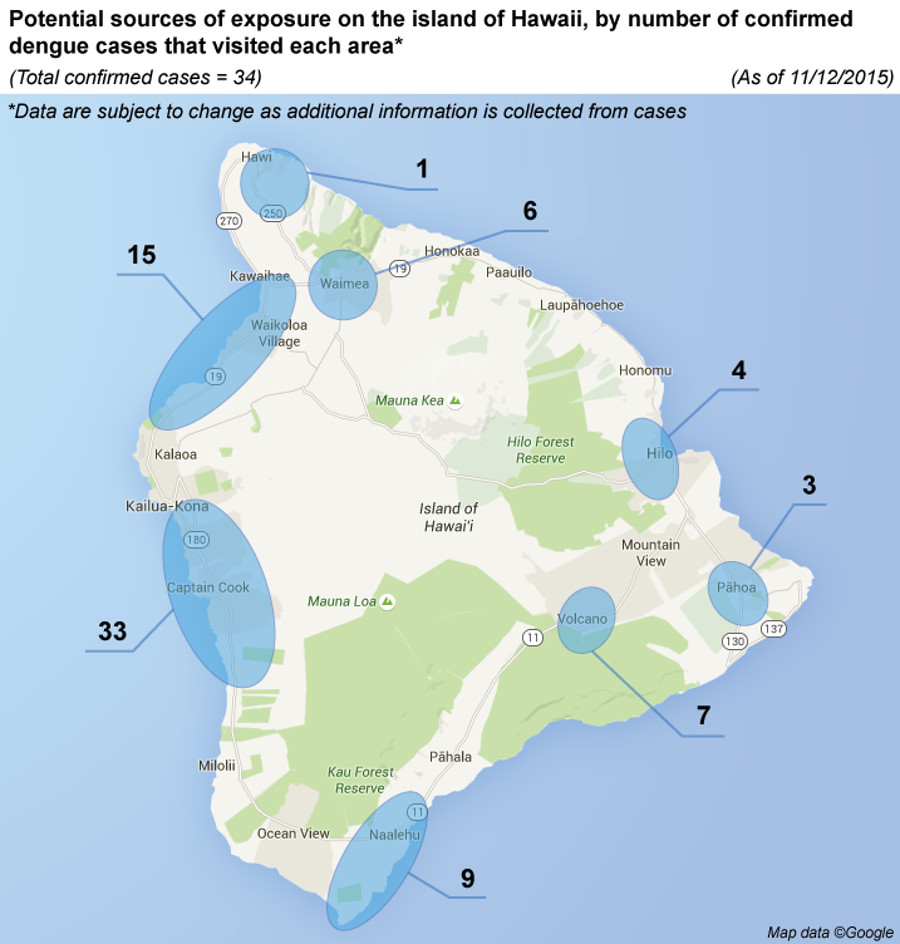Video by Dave Corrigan, filmed on Nov. 16 in Hilo.
HILO, Hawaii – The 5th in a series of public meetings on the Hawaii Island dengue fever outbreak was held at the Hilo High School Cafeteria on Monday evening. A large crowd gathered to hear the latest information from state and county officials. They also had plenty of questions. The two videos above present the entire meeting.
As of Monday, the Hawaii Department of Health reports the number of confirmed cases of locally-acquired dengue fever on the Big Island has risen to 56.

SOURCE: Hawaii Dept. of Health website
FACT SHEETWhat is Dengue Fever?
Dengue fever is a mosquito-borne disease that is transmitted to humans through the bite of an infected mosquito. Dengue cannot be spread directly from person to person. Symptoms typically begin in seven days and include high fever, headache, nausea, muscle aches, bone and joint pain and a red rash. There are no existing vaccines to prevent the illness or any specific treatment for dengue fever, however bed rest and acetaminophen are recommended.Dengue Fever in Hawaii
Dengue fever is typically not endemic or common in Hawaii, though it can be transmitted to mosquitoes that have bitten infected travelers coming from endemic areas, including Puerto Rico, Latin America, Southeast Asia and the Pacific.Currently, the areas of Hookena and Honaunau on the island of Hawaii have been identified as areas of concern for dengue transmission, although the entire island is considered to be at risk. While the current risk of dengue spreading to other islands is low, all islands should take measures to reduce mosquito breeding grounds.
Help us Fight the Bite!
The Hawaii State Department of Health has launched “Fight the Bite,” a comprehensive public education campaign to inform the public and urge their help in keeping Hawaii dengue-free.Although spraying or treating of areas by DOH’s Vector Control is ongoing, the most effective method of reducing the spread — and ultimately eliminating dengue — is to minimize, or prevent, being bitten by an infected mosquito.
To prevent catching or spreading dengue, apply mosquito repellant, wear light-colored long-sleeved shirts and pants, and avoid areas with high mosquito concentration during the early morning and late afternoon periods when mosquito activity is greatest. Removing areas where mosquitoes can lay eggs is also key. Clear all areas with standing water and consider spraying potential areas with heavy mosquito populations with insecticides. If you are ill and worried that you might have dengue fever, contact your healthcare provider.
More Information
Website: http://health.hawaii.gov/
Phone: Aloha United Way 2-1-1
Fight the Bite Flyer: http://bit.ly/fightthebiteflyer
Facebook: https://www.facebook.com/HawaiiDOH
Twitter: http://www.twitter.com/HIgov_Health
Social media hashtag: #FightTheBite
Clinician Information: http://health.hawaii.gov/docd/updates-and-resources-for-clinicians/.
Suspected Cases: Contact DOH, Disease Outbreak Control Division at 808-586-4586
LATEST NEWS: The Hawaii Island dengue fever outbreak


by Big Island Video News7:22 am
on at
STORY SUMMARY
HILO: The 5th in a series of public meetings on the Hawaii Island dengue fever outbreak was held at the Hilo High School Cafeteria on Monday evening. A large crowd gathered to hear the latest information from state and county officials. They also had plenty of questions. The two videos above present the entire meeting.